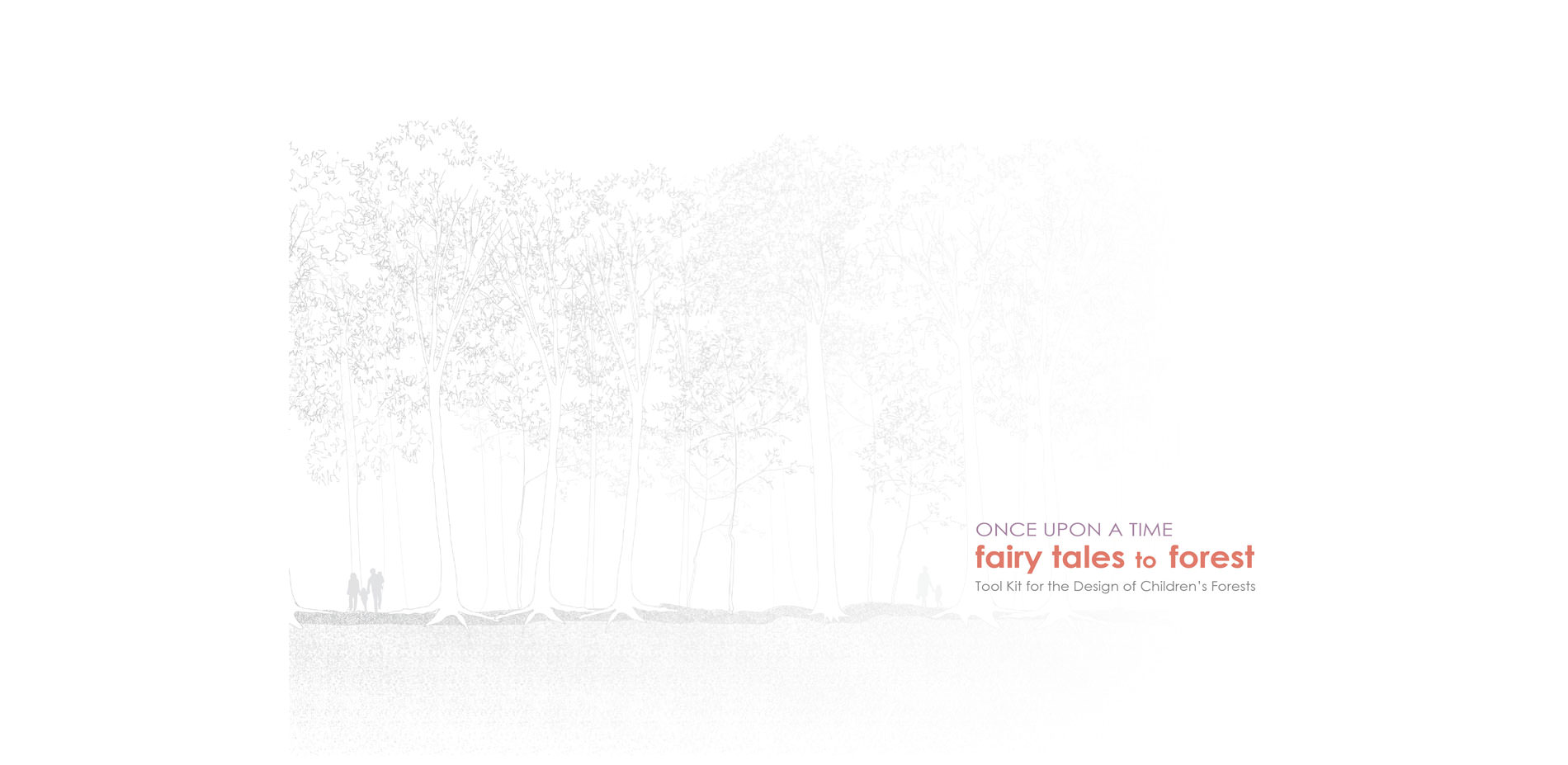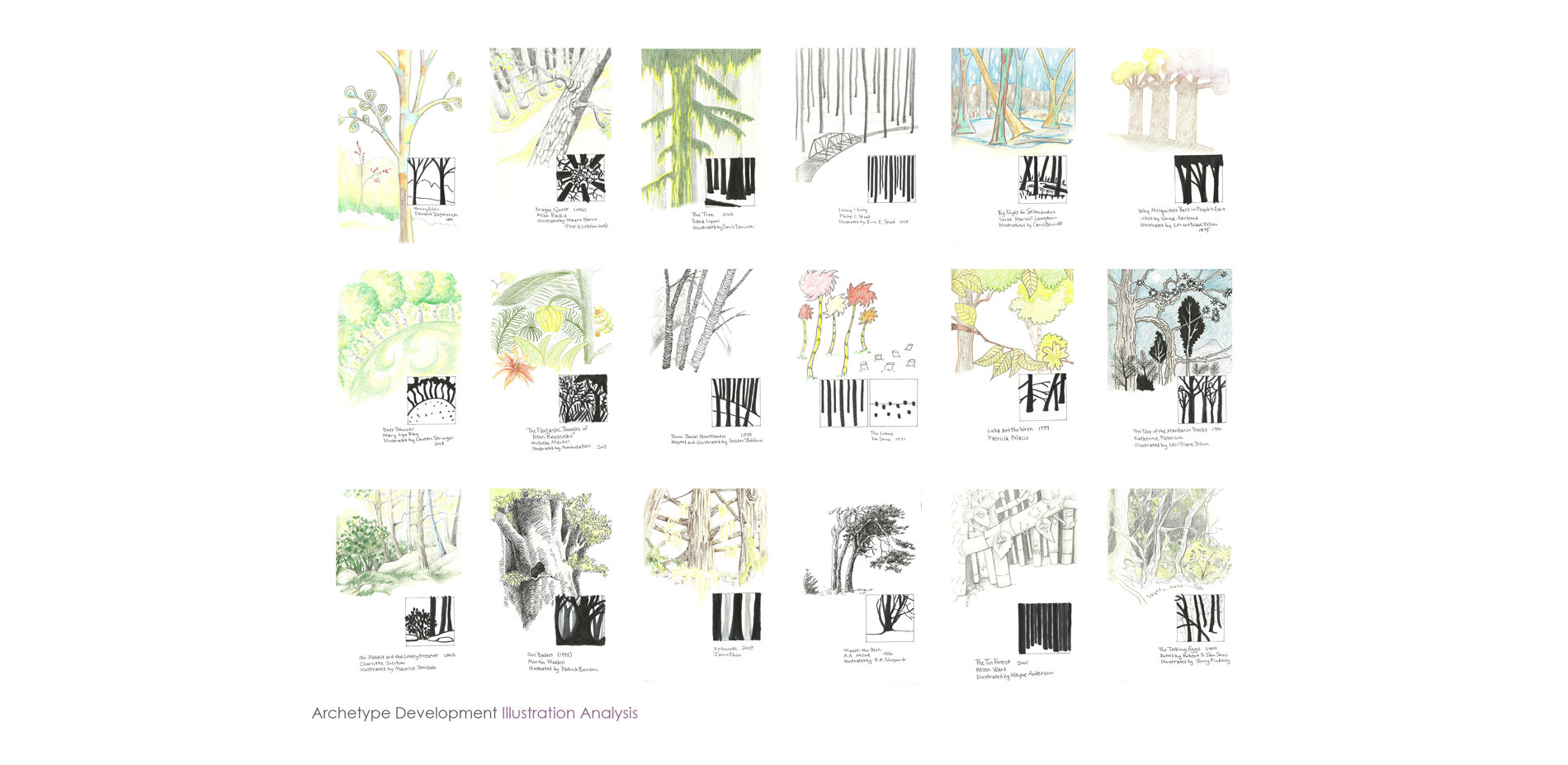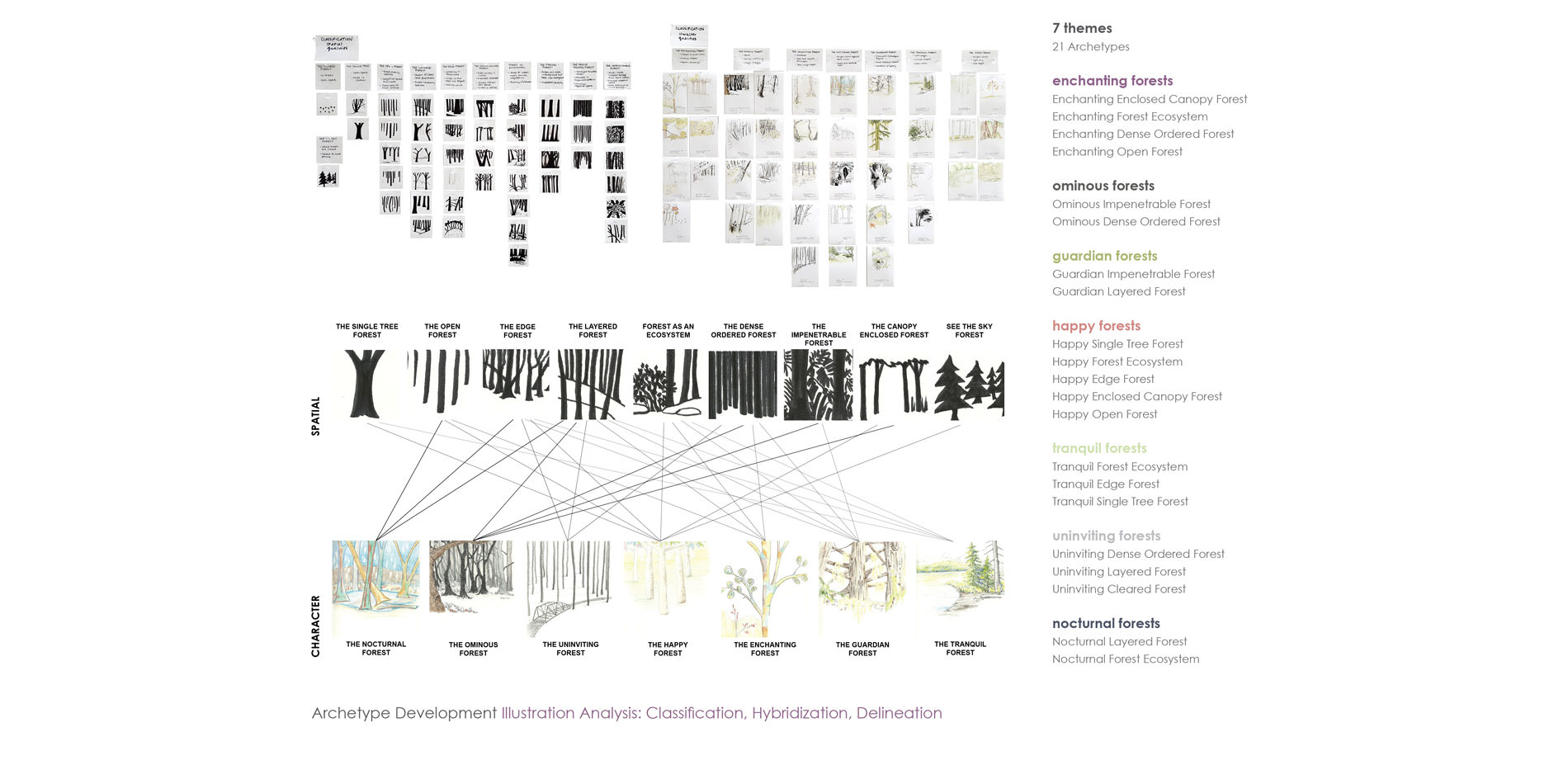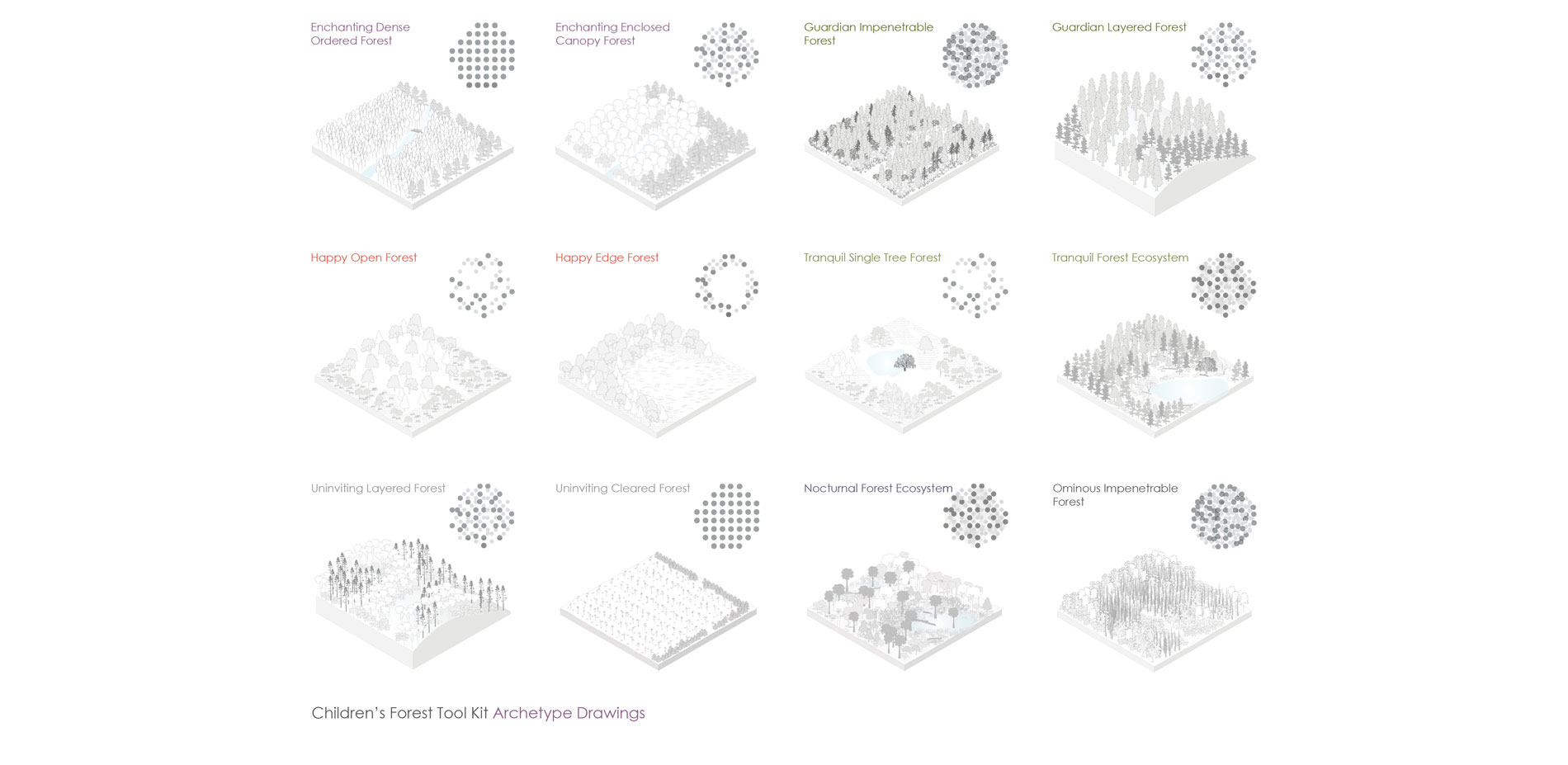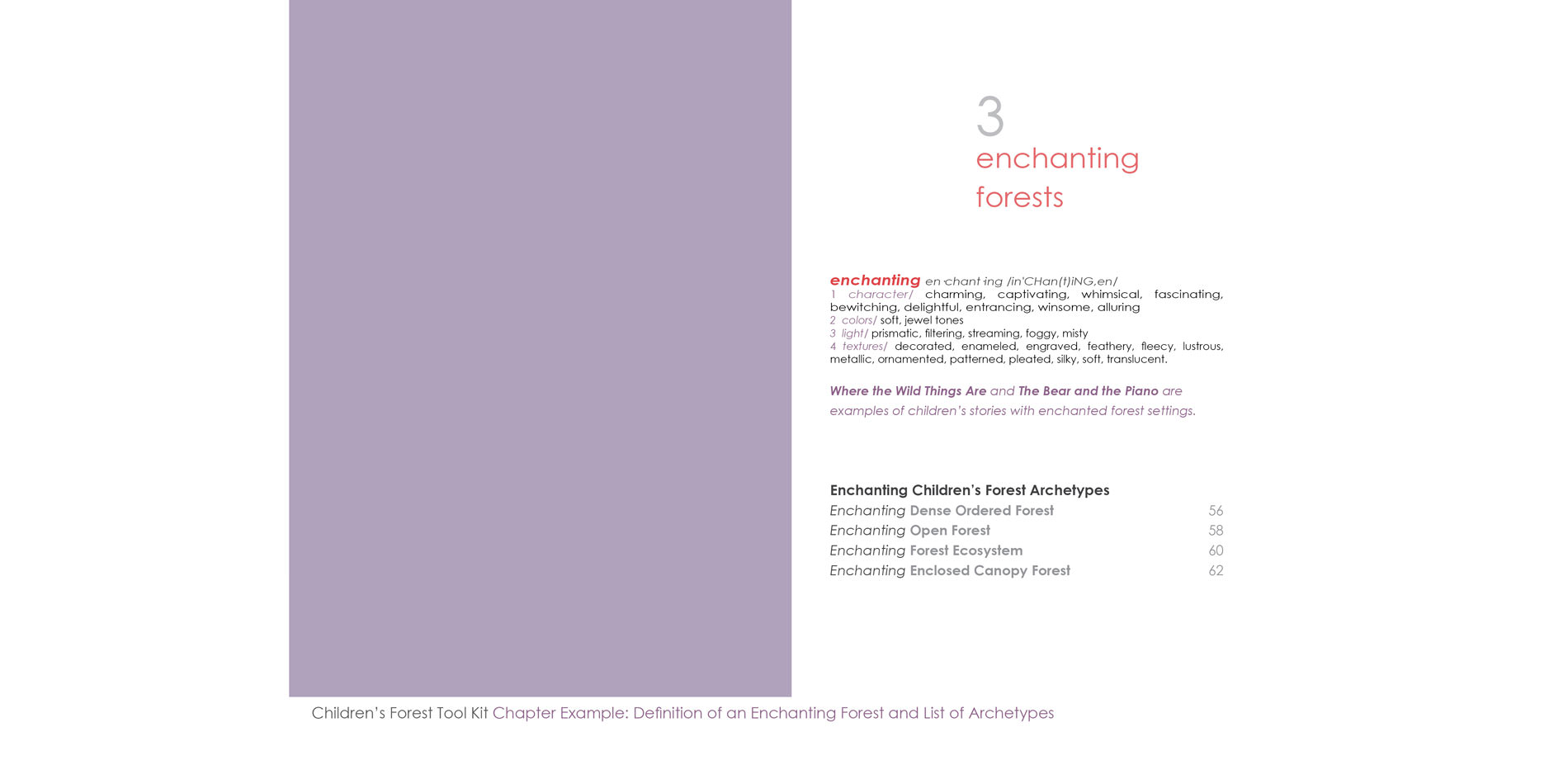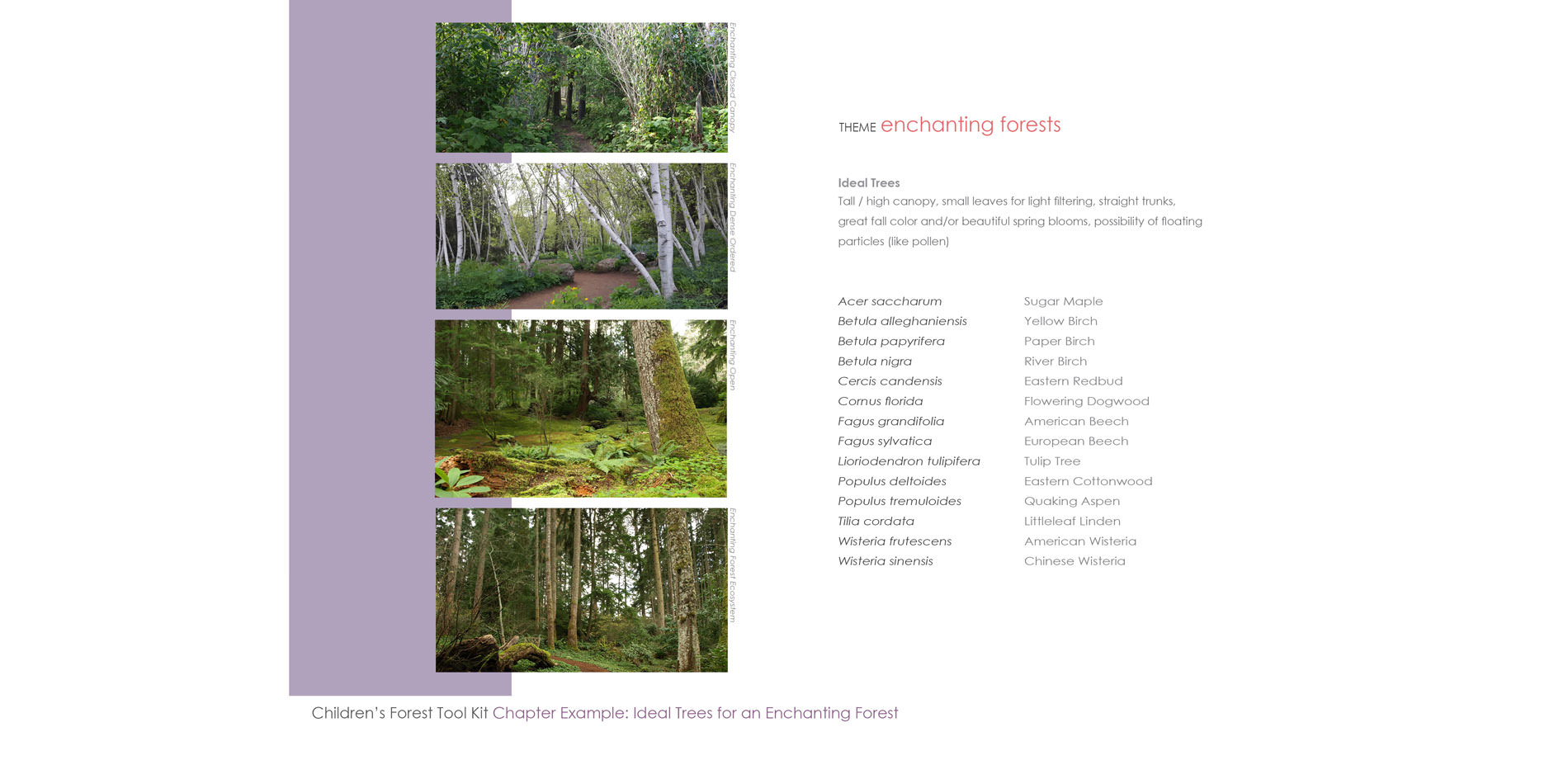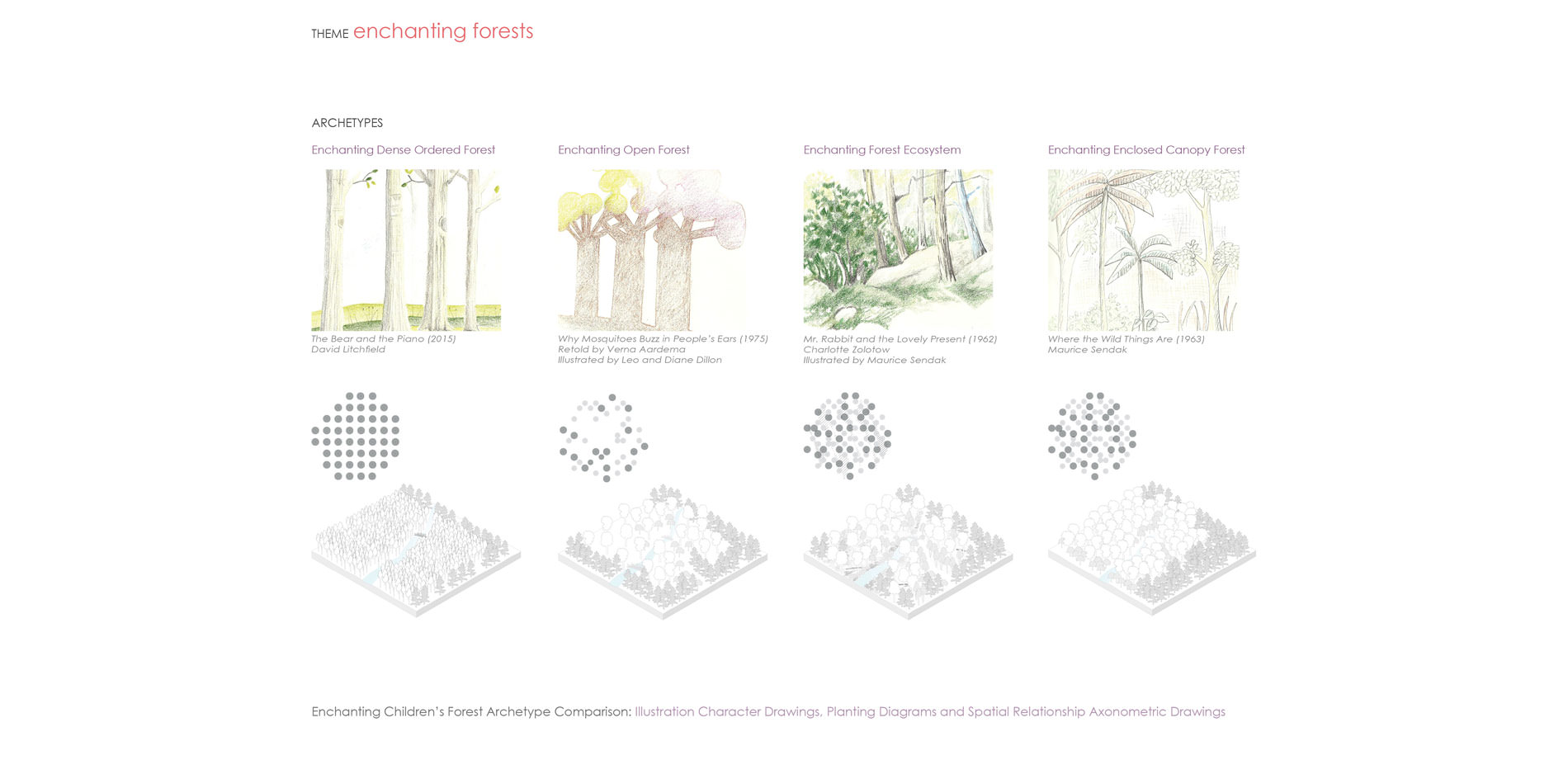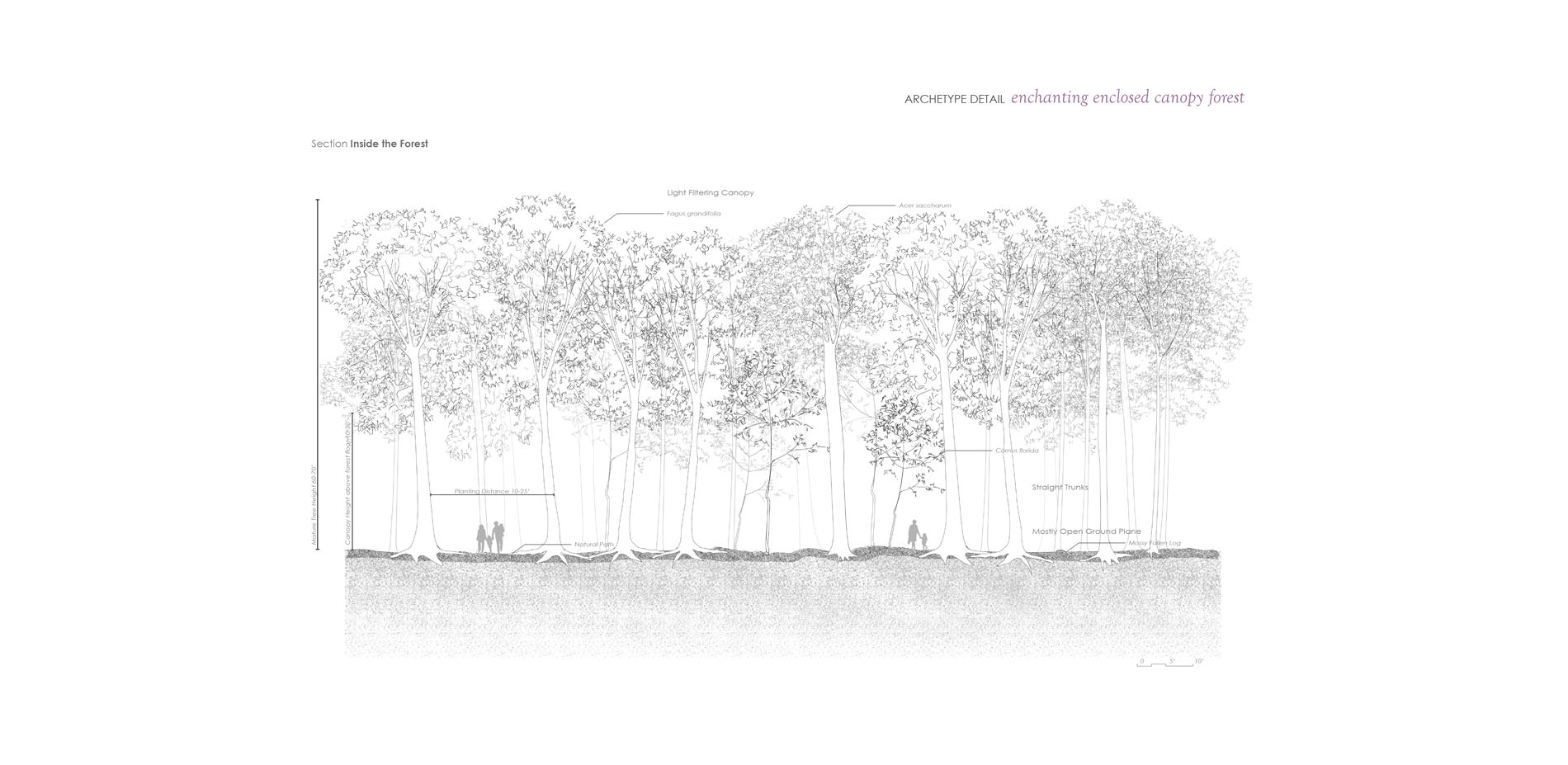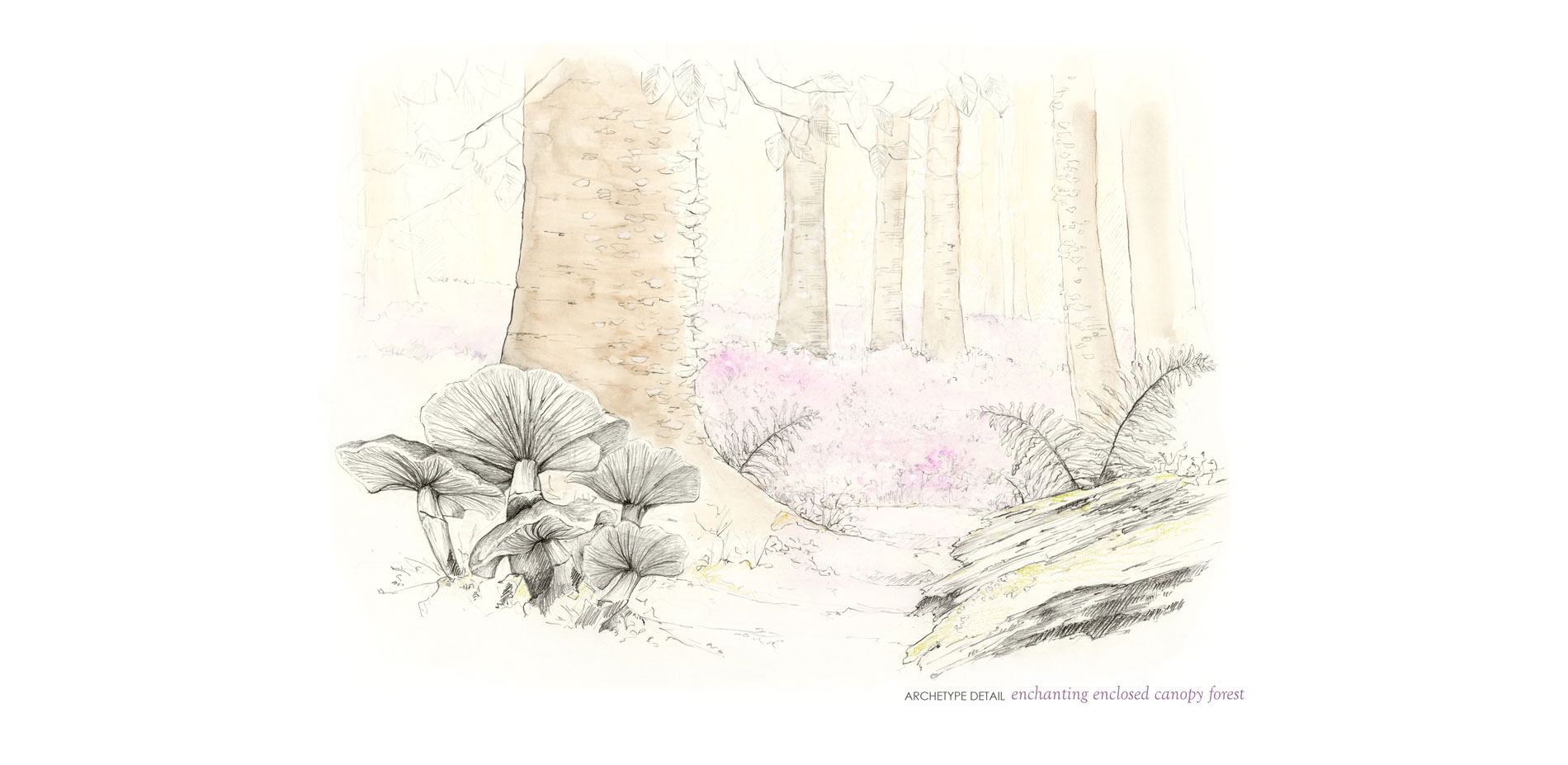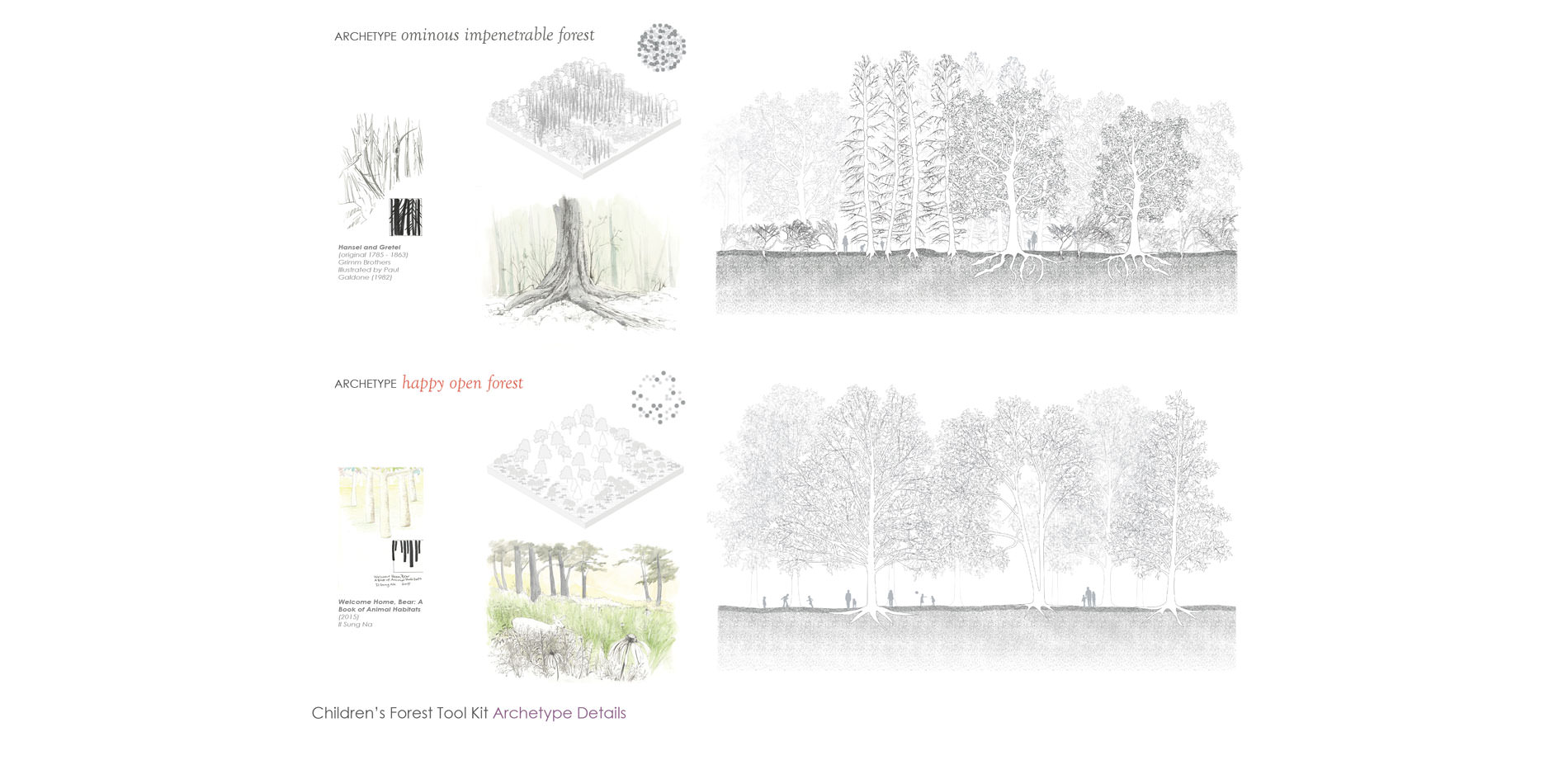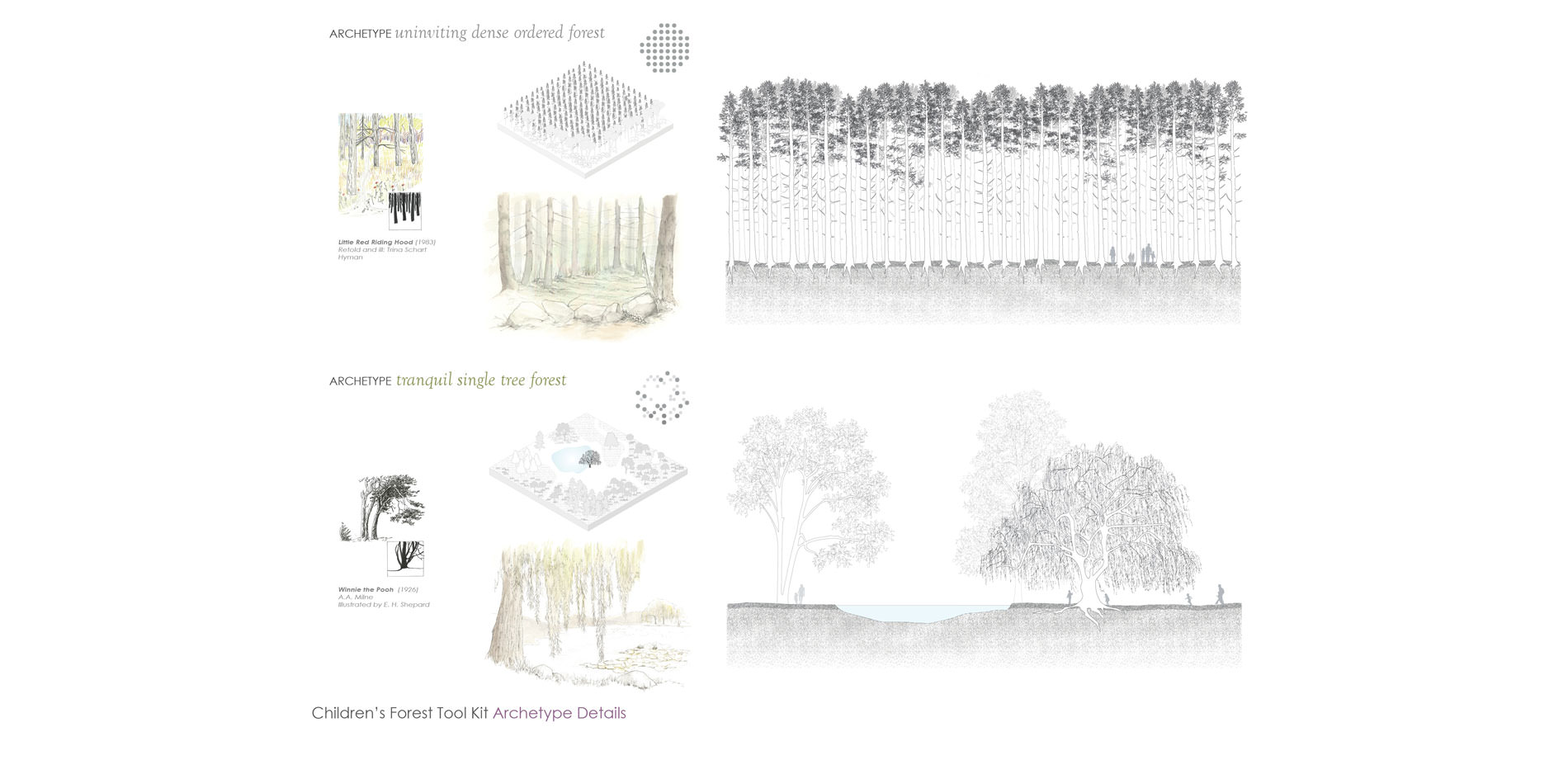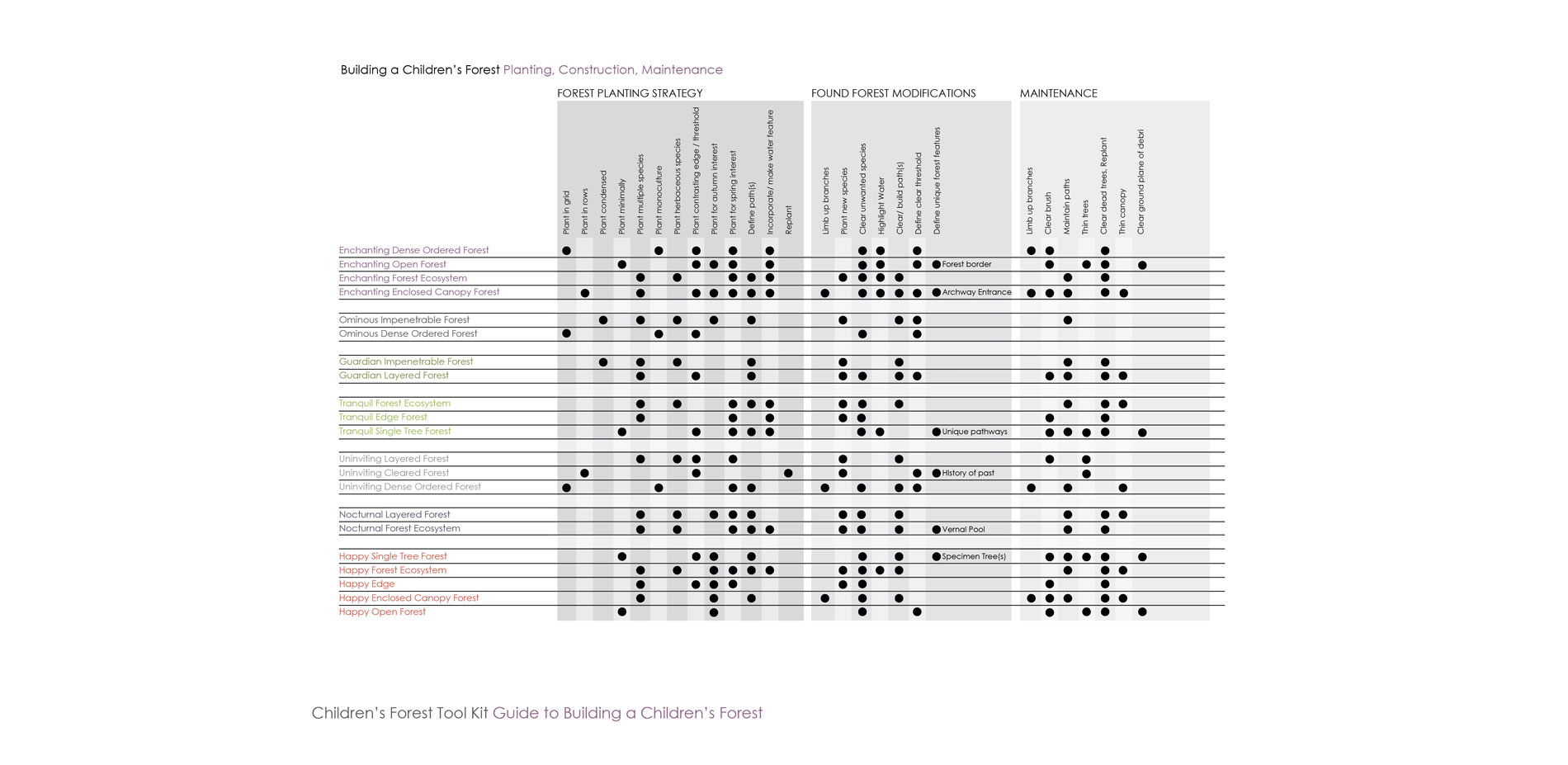Fairy Tales to Forest
HONOR
Research
Amy Taylor, Student ASLA | Faculty Advisor: Jacob Boswell, ASLA
Ohio State University
It opens a door for thinking in lots of different ways about how we respond on an emotional level to forests.
- 2017 Awards Jury
PROJECT STATEMENT
How we interact with our environment is influenced by our encounters with nature at an early age, whether these encounters are actual experiences with nature or vicarious experiences through other means. For example, we create images of place in our minds based on stories we hear as children. These stories are shaped by societal views and cultural values in regards to how environment is perceived. We often learn about the forest before we experience it, commonly through portrayal in children’s literature. Fairy Tales to Forest was a study of the perception of forest in children’s literature that guided the development of a design tool kit of children’s forest archetypes. This project is an innovative contribution to landscape architecture for two reasons. It highlights a means in which to design and build children’s forests as an immersive family landscape. It also introduces a methodology to analyze and design a site inspired by cultural values. These efforts foster the ability to connect the human directly to the natural or built environment through activities being practiced at home.
PROJECT NARRATIVE
Children grow up with different surrounding environments and form perceptions about forest through means like television, games and books – all of which shape their perception of the world around them. Reading about the great adventures of Winnie the Pooh, gives the perception of a tranquil, friendly forest while Hansel and Gretel, where children are lost in the forest and nearly eaten by a witch, may raise anxieties about the forest. With these simple observations, I was curious what the perception of forest is in children’s literature and how I, as landscape architect, can develop new children’s forest archetypes that can be employed in landscape design that would connect children to the natural environment through these literary experiences.
As evidence builds for the beneficial impacts of being active outdoors, initiatives continue that encourage children and families to connect with the outdoors and engage in physical activity. This, in turn, has led the federal government to increasingly invest resources in the development of Children’s Forests. The goals of these forests include community engagement, conservation education and an appreciation for the outdoors. 1 While these are laudable goals, my initial critique of this forest network concerns accessibility to these spaces as they are spread widely across the nation, but mostly in the west. Additionally, I feel these goals lack a key component: the experience. These landscapes are built to meet ecological goals but do not capitalize on the child’s imagination that could foster a profound interconnectedness to the forest.
In “Exploring Woodland Design,” Roland Gustavsson describes the structure of woodlands and how these rich environments can be designed to appeal to all of the senses. He briefly touches on a relatively new concept, the adventurous woodland, which emphasizes the importance of “designing woodlands that support children, their development, their creativity and their play.”2 Fairy Tales to Forest is an exploration of that very concept, focusing on the experience of forest as depicted in children’s literature.
Phase I of the Fairy Tales to Forest project employed a qualitative content analysis of children’s literature that defined the role forests play in children’s literature. Key elements in this phase included selecting illustrated fiction books, analyzing the text and illustrations, categorizing the various depictions of forest and delineating new children’s forest archetypes informed by this analysis. This approach has been used in other disciplines and I based my analysis on precedents that use children’s literature for informing research and engaging social change.
Using The Children’s Literature Comprehensive Database, I searched for fiction books that included the keywords of “forest” or “woods,” for children ages 0 – 10 years. It was important that selected books were widely available to all children, so I limited the search to award winning books. Public libraries are more likely to acquire award-winners, representing greater potential access and reach to these stories. The final analysis included 112 books.
The text analysis of each book in the final list included a story summary and answered the question “What role does the forest play in the story?” I approached the remainder of the text analysis as I would initially approach a site for design. If addressed in the book, I recorded the forest description, human and wildlife interaction with the forest and any significant climatic influences.
To evaluate the illustrations in the books, my analysis observed spatial relationships, tone and illustration style for each book. I drew an abstract black and white spatial diagram and a colored sketch interpreting the style and character of the illustrations for each book.
I classified collected information into three classification sets. The first used the text analysis to identify common roles of forest in children’s stories. The second set sorted the spatial diagrams according to tree density, positive/ negative space, tree organization, and tree relationships to other ecosystems. Finally, I classified the character qualities, looking specifically at forest personality.
Through the classification process, I recognized that the forest experience is defined by spatial and character qualities of the landscape. Lining up the spatial classifications across from the character classifications, I connected possible hybrid forest types. These results were validated by classifying the 112 books into these hybrid categories. Happy open forests were the most prevalent forest type, followed by: ominous impenetrable forest; uninviting dense ordered forest; happy single tree forest; and tranquil forest ecosystem. If a hybrid type was represented by three or more books, it became a new children’s forest archetype. Through this process, I identified 7 forest themes: enchanting, ominous, guardian, happy, uninviting, tranquil and nocturnal forests embodying 21 new archetypes.
Phase II of the project was the development of a tool kit to guide the design and maintenance of the children’s forest archetypes. This tool kit is a handbook that designers can refer to when considering this type of environmental design for families. Key elements in this phase included: defining children’s forest archetypes; visiting forests for design reference; and creating drawings to highlight important forest design features. Illustrations, as well as axonometric drawings, diagrams and sections, were drawn to describe the children’s forest archetypes. The research produced 21 options for how a children’s forest could look and feel. These forests can be new designs grown specifically for a desired archetype or an existing forest could be modified to create a particular experience. I want a designer to feel comfortable designing a children’s forest experience guided by my descriptions of that experience, but using their own design aesthetic.
This research contributes to the field of landscape architecture in two distinct ways. First, academic writing on the topic of forest is project specific, historical or ecological. Theoretical research is folded into the larger context of nature or wilderness. In Fairy Tales to Forest, the forest itself gets the spotlight and a fresh look at how these dynamic typologies can be the focus of family landscapes. Second, from a methodological perspective, landscape architects do not typically consider the study of children’s literature as an applicable tool for design. This analysis method provides a direct connection between the human and the environment through the reading of books. This methodology can also be applied to other foci to introduce social and cultural values in design.
With the conclusion of this project, there are two avenues of interest that have great potential to be extended with further research. The first would be to collect experiential data from children who have interacted with a children’s forest. How do children anticipate a forest and what are their experiences while inside? How can this data integrate with story book analysis to create more engaging forest experiences? The second potential extension of this work is the recognition that forests experience slow succession, as well as short term ephemeral timelines. Forest archetypes have the potential to evolve as a forest grows older and seasons change. Furthermore, this project could significantly contribute to the expanding palette for Nature Play spaces and Children’s Outdoor Environments.
How we interact with our environment is influenced by our encounters with nature at an early age. This project rekindles the spirit of the children’s story and facilitates design toward a greater connection to nature and our surrounding environments. Through children’s literature, I have rediscovered the magic of designing for the human experience. My children’s forest tool kit empowers fellow designers to create experiential landscapes that have a lasting impact on how we interact with our surroundings. Whether rural or urban, children’s forests have the capacity to encourage activity, discover nature, nurture health, free the mind and unleash the imagination.
1 "Creating a National Network of Children’s Forests". USDA Forest Service.
2 Gustavsson, Roland. “Exploring woodland design.” In The Dynamic Landscape, edited by Nigel Dunnett and James Hitchmough.
